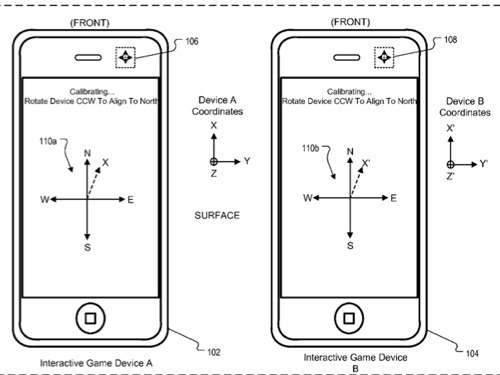According to a new patent (number 20100279768) Apple is eyeing ways for iPhone/iPod touch/iPad users to use features of the devices — such motion detection, GPS and camera — to play and compete with others in a real-life 3D space.
The patent is for interactive gaming with co-located, networked direction and location-aware devices. An interactive game environment includes two or more co-located, networked, direction and location aware interactive game devices. The game devices share a common reference coordinate frame (e.g., a three-dimensional Cartesian coordinate frame).
Each game device maintains its own device state (e.g., position, orientation, time) in the reference coordinate frame. Each interactive game device shares its device state with the other interactive game devices using communication technology (e.g., Bluetooth, Wi-Fi, cellular). Each interactive game device can use the device states of the other interactive game devices to project the relative positions and orientations of the other interactive game devices into a local, fixed coordinate frame of the interactive game device. These projections allow each interactive gaming device to know the position and orientation of the other interactive game devices in an interactive game environment defined by the reference coordinate frame. The inventors of the patent are Ronald Keryuan, Rob Mayor, Isabel Mahe and Patrick Piemonte.
Here’s Apple’s background and summary of the invention: “Modern mobile devices integrate a variety of communication technologies with geopositioning technology and sensors. The communication technologies (e.g., cellular, Wi-Fi, Bluetooth) allow users to communicate with other users in a variety of operating environments. Geopositioning technologies allow users to receive detailed digital maps and location-based services.
“Various sensors integrated in the mobile device receive input from the operating environment and provide output for a variety of interesting and useful applications running on the mobile device. For example, an accelerometer can detect when a device is held in portrait or landscape orientation, and then adjust a user interface based on the detected orientation. Sensors, such as the accelerometer in Apple Inc.’s iPhone. have also been used in games. The user manipulates the iPhone. in response to game action, such as trying to guide a virtual ball through a virtual maze or steer a virtual car or boat through a virtual racetrack.
“An interactive game environment includes two or more co-located, networked, direction and location aware interactive game devices. The game devices share a common reference coordinate frame (e.g., a three-dimensional Cartesian coordinate frame). Each game device maintains its own device state (e.g., position, orientation, time) in the reference coordinate frame. Each interactive game device shares its device state with the other interactive game devices using communication technology (e.g., Bluetooth, Wi-Fi, cellular).
“Each interactive game device can use the device states of the other interactive game devices to project the relative positions and orientations of the other interactive game devices into a local, fixed coordinate frame of the interactive game device. These projections allow each interactive gaming device to know the position and orientation of the other interactive game devices in an interactive game environment defined by the reference coordinate frame. An interactive game display can be generated and displayed on each game device. Various interactive games (e.g., Laser Tag) can utilize the relative positions and orientations shared between the interactive game devices to provide an enriched interactive gaming experience.”




